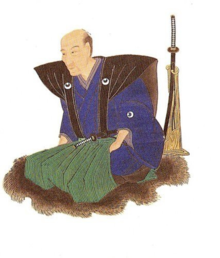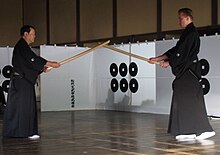Hokushin Ittō-ryū


Hokushin Ittō-ryū Hyōhō (北辰一刀流兵法) is a koryū (古流) which was founded in the late Edo period (1820’s) by Chiba Shusaku Narimasa (千葉周作成政, 1794- 1856). He was one of the last masters who was called a Kensei (sword saint).
Curriculum and Characteristics
The curriculum of the ryūha contains mainly Kenjutsu, Battōjutsu, Naginatajutsu and Jūjutsu. But the main weapons used are the long sword and short sword (Katana and Wakizashi).[1]
The Hokushin Ittō-ryū is a very intense dueling style, which focuses on simple and fast techniques where no unnecessary movements are made. Controlling the enemy’s center line with the Kiri-Otoshi and dominating him with extremely fast tsuki-waza are the signature techniques of this ryūha. The principles of this style are that a perfect technique should contain defence and offense in one action.
Characteristic for the training is the use of Onigote (heavily padded gloves) like in its ancestor styles Ono-ha Ittō-ryū and Nakanishi-ha Ittō-ryū which are used in several Kumitachi-Kata (two person practice).[2] This kind of training became more and more obsolete at the end of the Edo-period with the spread of Gekiken and the use of Bogu and Shinai.
This style is also one of the few remaining ryūha which is still training Kumitachi with Shinken (real swords). One has in order to become Shihan, master every technique with Shinken (Kumitachi and Battōjutsu). This is a very dangerous training method but guarantees, that the quality of those masters is held on a very high level.[3]
Famous Swordsmen
At the end of the Bakumatsu period (1853-1867), the Hokushin Ittō-ryū was one of the three biggest and most famous ryūha all over Japan. Swordsmen of the Hokushin Ittō-ryū had a strong influence on the development of modern Kendō in the late 19th century. Also many famous and politically influential people were masters of this swordsmanship school.
Some of the most prominent names:
- Sakamoto Ryōma (famous revolutionary)
- Itō Kashitarō (military advisor of the Shinsengumi)
- Yamaoka Tesshū (founder of the Ittō Shōden Mutō-ryū)
- Chiba Sana (daughter of the 1st Chiba-dōjō headmaster, also known as Chiba Sanako)
- Yamanami Keisuke (vice commander of the Shinsengumi)
- Tōdō Heisuke (captain of the 8th squad of the Shinsengumi)
- Kiyokawa Hachirō (founder of the Kiyokawa-school and Roshigumi)
- Yoshimura Kanichirō (Kenjutsu instructor of the Shinsengumi)
- Negishi Shorei (13th Soke of the Annaka-han Araki-ryu and founder of the Negishi-ryu (Shurikenjutsu))
- Okada Sadagoro (Famous swordsman of the Bakumatsu and Meiji period and 14th Soke of the Annaka-han Araki-ryu)
- Naitō Takaharu (A key developer of modern Kendo)
- Takano Sasaburo (A key developer of modern Kendo)
- Monna Tadashi (A key developer of modern Kendo)
- Mochida Moriji (One of the most famous Kendoka of the 20th century)
Ranking System
The Hokushin Ittō-ryū has three teaching steps:
- Shoden 初伝 (entry-transmission)
- Chūden 中伝 (middle-transmission)
- Okuden 奥伝 (inner-transmission)
Like many other koryū, the Hokushin Ittō-ryū traditionally awards makimono-scrolls and/ or inka-jō. There is no modern Dan system in the school. The traditional five scrolls of Hokushin Ittō-ryū are:
- Kirigami 剪紙
- Hatsumokuroku 初目録
- Kajōmokuroku / Seigandenju 箇条目録 / 星眼伝授
- Chūmokuroku / Menkyo 中目録 / 免許 (full transmission of all techniques)
- Daimokuroku / Menkyo-Kaiden 大目録 / 免許皆伝 (full transmission of the ryūha)
Lineage
Old Main lines
The two main lines were that of the Kaiso Chiba Shusaku Narimasa and his Edo-Genbukan, the other was that of his brother Chiba Sadakichi Masamichi with the Chiba-Dôjô. In the mid Taisho period, the line of the Edo-Genbukan became extinct. The Chiba-Dojo line, unlike that of the Edo-Genbukan, has survived until today with Ōtsuka Yōichirō Masanori as the 6th Soke. [4][5]
Edo-Genbukan
- 1st Chiba Shūsaku Narimasa
- 2nd Chiba Kisotarō Takatane
- 3rd Chiba Eijirō Nariyuki (he led the Genbukan until his death in 1862)
- 4th Chiba Michisaburō Mitsutane
- 5th Chiba Shūnosuke Koretane
Chiba Shûnosuke Koretane restored the Edo-Genbukan in 1883 with the help of Inoue Hachirō and Yamaoka Tesshū. The Edo-Genbukan was closed around the 20th – 30th year of the Meiji-period. The exact date is unknown.[6]
Chiba-Dojo
- 1st Chiba Sadakichi Masamichi
- 2nd Chiba Jūtarō Kazutane
- 3rd Chiba Tō-ichirō Kiyomitsu
- 4th Chiba Tsukane
- 5th Chiba Hiroshi Masatane
- 6th Ōtsuka Yōichirō Masanori
On July 1, 2013 the Chiba family head of the line of Chiba Sadakichi, gave the title of the 6th Soke of the Hokushin Ittō-ryū Hyōhō Chiba-Dōjō to Ōtsuka Yōichirō Masanori in order to preserve the old Chiba line of the ryūha.
Side lines
At the middle of the Meiji-period there were many side branches, founded by pupils of the two main lines. One of the most famous was the Tobukan in Mito. It was established by Ozawa Torakichi, a student of the Edo-Genbukan. Ozawa Torakichi was also an instructor at the Kodokan, the official clan school of the Mito-clan. After the Meiji-restoration and the abolishment of the traditional clan system the Kodokan was closed, so in order to continue teaching, Ozawa Torakichi opened his own Dôjô, the Tobukan. There he taught Hokushin Itto-ryu together with Shin Tamia-ryu. Up until today, the Ozawa family is still preserving the teachings of its first headmaster at the Tobukan in Mito.
Mito-Tobukan (Ozawa-ha)
- 1st Ozawa Torakichi
- 2nd Ozawa Ichiro
- 3rd Ozawa Toyokichi
- 4th Ozawa Takeshi
- 5th Ozawa Kiyoko
- 6th Ozawa Tadahiko
- 7th Ozawa Satoshi
Otaru-Genbukan (Noda-ha)
(This Dojo is not to be mistaken with the Edo-Genbukan)[7]
- 1st Noda Shiro (founder of the Otaru-Genbukan)
- 2nd Kobayashi Yoshikatsu
- 3rd Konishi Shigejirô (moved the Dôjô to Tokyo and renamed it Suginami-Genbukan)
- 4th Konishi Shinen Kazuyuki
References
- ^ Hall, David (2013-03-25). Encyclopedia of Japanese Martial Arts. p. xiv. ISBN 1568364105.(in English)
- ^ Skoss, Diane (April 2002). Keiko Shokon (Classical Warrior Traditions of Japan). p. xiv. ISBN 1890536067.(in English)
- ^ Chiba, Eiichiro (1942). Chiba Shusaku Ikoshu. Tokyo, Japan. p. xiv. ISBN 4-88458-220-9.
{{cite book}}: CS1 maint: location missing publisher (link)(in Japanese) - ^ Ken / Nihon no Ryuha. Tokyo, Japan. 2014. ISBN 477305512X.
{{cite book}}: CS1 maint: location missing publisher (link)(in Japanese) - ^ Chiba, Eiichiro (1942). Chiba Shusaku Ikoshu. Tokyo, Japan. p. xiv. ISBN 4-88458-220-9.
{{cite book}}: CS1 maint: location missing publisher (link)(in Japanese) - ^ Chiba, Eiichiro (1942). Chiba Shusaku Ikoshu. Tokyo, Japan. p. xiv. ISBN 4-88458-220-9.
{{cite book}}: CS1 maint: location missing publisher (link)(in Japanese) - ^ Konishi, Shigejirō. Hokuto no Ken. Tokyo, Japan. p. 73. ISBN 4-309-90118-2.(in Japanese)
